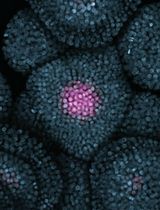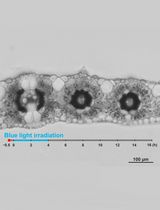- EN - English
- CN - 中文
In vitro Microtubule Binding Assay and Dissociation Constant Estimation
体外微管结合实验和解离常数估算
发布: 2016年03月20日第6卷第6期 DOI: 10.21769/BioProtoc.1759 浏览次数: 15395
评审: Arsalan DaudiMarta BjornsonTamara Vellosillo
Abstract
Microtubules (MTs) support an astonishing set of versatile cellular functions ranging from cell division, vesicle transport, and cell and tissue morphogenesis in various organisms. This versatility is in large mediated by MT-associated proteins (MAPs). The neuronal MAP Tau, for example, is stabilizing MTs in axons of the vertebrate nervous system and thus provides the basis for enduring axonal transport and the long life span of neurons (Mandelkow et al., 1994). Tau has been shown to bind to MTs directly in vitro and also to promote their nucleation from α-/β-tubulin subunits (Goode et al., 1994). Recently, we identified a plant-specific protein family called “companion of cellulose synthase” (CC), which was shown to bind MTs and enhance dynamics of the cortical MT array in plant cells under salt stress (Endler et al., 2015). The CCs were therefore hypothesized to help plant cells cope with stress conditions and thereby maintain biomass production under adverse growth conditions. Here, we provide detailed experimental information on in vitro MT binding assays, which allow assessing whether a protein of interest is binding to MTs. The assay utilizes the high molecular weight of MTs in a spin down approach and enables the determination of the dissociation constant Kd, a measure for the protein’s binding strength to MTs.
Materials and Reagents
- Tubes, with Snap-On Cap, Polypropylene (1.5 ml, 11 x 38 mm) Natural (Beckman Coulter, catalog number: 357448 )
Note: Any ultracentrifuge tubes can be used. Make sure the volume of the tubes does not exceed 1.5 to 2 ml. Otherwise handling of the assay is unfeasible. - PIPES (Sigma-Aldrich, catalog number: P6757 )
- Trizma® base (Sigma-Aldrich, catalog number: T1503 )
- Magnesium chloride (MgCl2) (Sigma-Aldrich, catalog number: M8266 )
- Ethylene glycol-bis(2-aminoethylether)-N, N, N’, N’-tetraacetic acid (EGTA) (Sigma-Aldrich, catalog number: E3889 )
- Glycerol (Sigma-Aldrich, catalog number: G5516 )
- Bovine Serum Albumin (BSA) (Sigma-Aldrich, catalog number: A2153 )
- Paclitaxel (Taxol) (Sigma-Aldrich, catalog number: T7402 )
- Dimethyl sulfoxide (DMSO) (Sigma-Aldrich, catalog number: 276855 )
- Guanosine 5’-triphosphate sodium salt hydrate (GTP) (Sigma-Aldrich, catalog number: G8877 )
- Tubulin protein, bovine, lyophilized (> 99% pure) (Cytoskeleton Inc., catalog number: TL238 ) or Tubulin protein (> 99% pure): porcine brain (Cytoskeleton Inc., catalog number: TL240 )
- Microtubule-associated protein rich fraction: bovine brain (Cytoskeleton Inc., catalog number: MAPF )
- NuPAGE Novex 4-12% Bis-Tris Protein Gels, 1.0 mm, 15-well (Thermo Fisher Scientific, catalog number: NP0323PK2 )
Note: Any other 1D protein gel able to separate tubulin and the protein of interest works as well. - Brilliant Blue G (Sigma-Aldrich, catalog number: 27815 )
- Aluminum sulfate-(14-18)-hydrate (Sigma-Aldrich, catalog number: 368458 )
- 85% Orthophosphoric acid (Sigma-Aldrich, catalog number: 345245 )
- Sodium dodecyl sulfate (Sigma-Aldrich, catalog number: L3771 )
- Bromophenol blue (Sigma-Aldrich, catalog number: B0126 )
- 2-mercaptoethanol (Sigma-Aldrich, catalog number: M6250 )
- Brinkley buffer 1980 (BRB80) (see Recipes)
- BRB80 Cushion buffer (see Recipes)
- Taxol stocks (see Recipes)
- GTP stocks (see Recipes)
- Tubulin stocks (see Recipes)
- MAP fraction stocks (see Recipes)
- BSA stocks (see Recipes)
- Colloidal Coomassie stain (see Recipes)
- Laemmli buffer (see Recipes)
Equipment
- Optima MAX-XP Ultracentrifuge (Beckman Coulter, catalog number: 393315 )
- TLA-55 Rotor Package, Fixed-Angle (45° Angle), Aluminium (Beckman Coulter, catalog number: 366725 )
Note: Any combination of ultracentrifuge and rotor can be used. - BIO RAD ChemiDOC MP Imaging System (Bio-Rad Laboratories, catalog number: 1708280 )
Note: A normal document scanner can be used to scan protein gels instead. The scanner needs to be able to export scans in an uncompressed format. - SDS-PAGE system to separate protein in 1D
- Vortex mixer
Software
- ImageJ (Fiji)
- Spreadsheet software (e.g., Microsoft Excel)
- GraphPad Prism Version 6.01 (or higher) (GraphPad Software Inc)
Procedure
文章信息
版权信息
© 2016 The Authors; exclusive licensee Bio-protocol LLC.
如何引用
Kesten, C., Schneider, R. and Persson, S. (2016). In vitro Microtubule Binding Assay and Dissociation Constant Estimation. Bio-protocol 6(6): e1759. DOI: 10.21769/BioProtoc.1759.
分类
植物科学 > 植物细胞生物学 > 细胞结构
植物科学 > 植物发育生物学 > 综合
细胞生物学 > 细胞结构 > 细胞粘附
您对这篇实验方法有问题吗?
在此处发布您的问题,我们将邀请本文作者来回答。同时,我们会将您的问题发布到Bio-protocol Exchange,以便寻求社区成员的帮助。
提问指南
+ 问题描述
写下详细的问题描述,包括所有有助于他人回答您问题的信息(例如实验过程、条件和相关图像等)。
Share
Bluesky
X
Copy link












